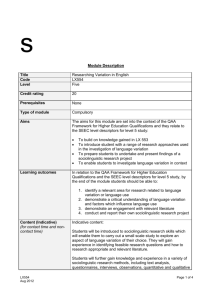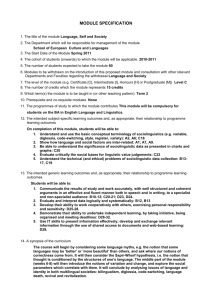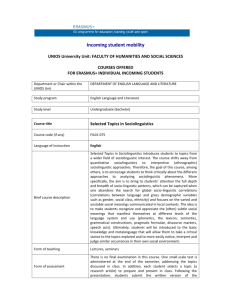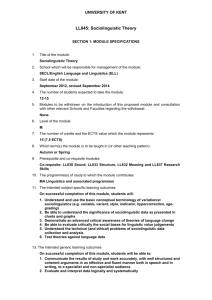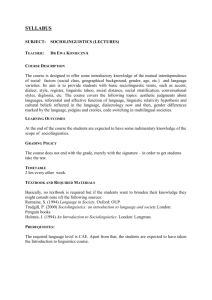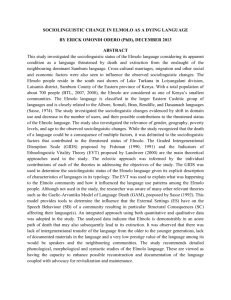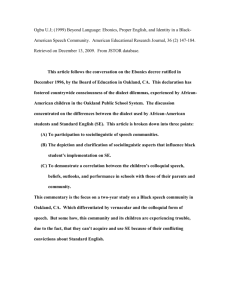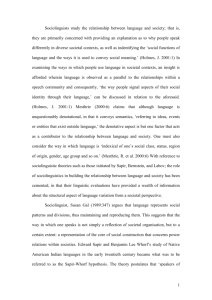AFRICAN-AMERICAN VERNACULAR ENGLISH: SELECTED
advertisement
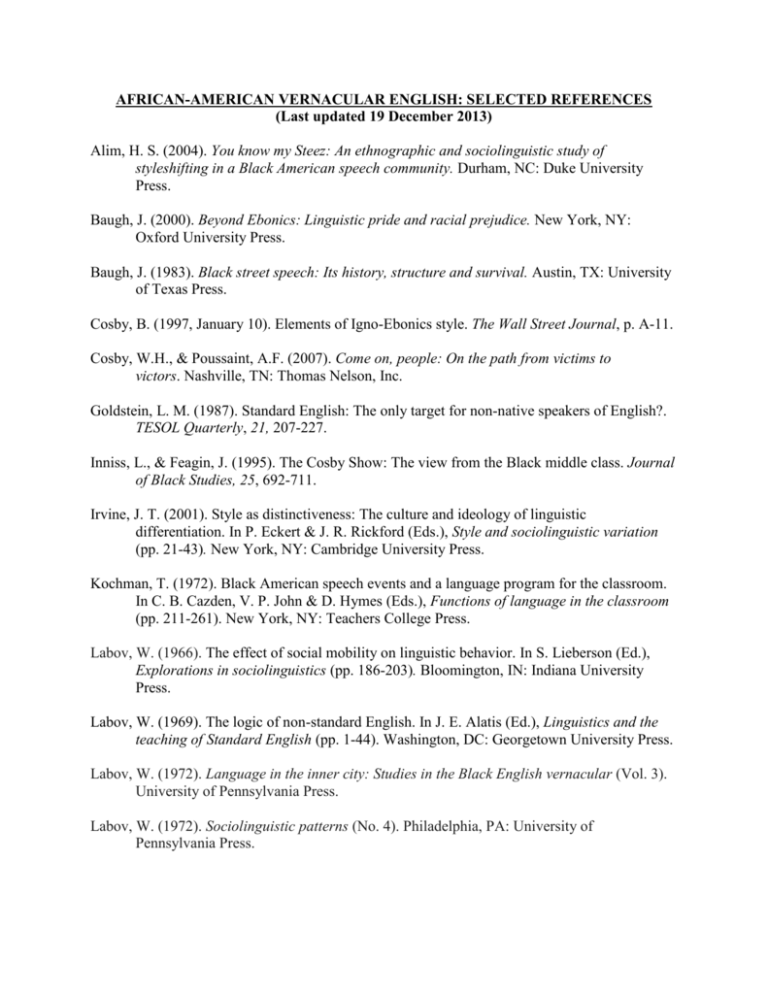
AFRICAN-AMERICAN VERNACULAR ENGLISH: SELECTED REFERENCES (Last updated 19 December 2013) Alim, H. S. (2004). You know my Steez: An ethnographic and sociolinguistic study of styleshifting in a Black American speech community. Durham, NC: Duke University Press. Baugh, J. (2000). Beyond Ebonics: Linguistic pride and racial prejudice. New York, NY: Oxford University Press. Baugh, J. (1983). Black street speech: Its history, structure and survival. Austin, TX: University of Texas Press. Cosby, B. (1997, January 10). Elements of Igno-Ebonics style. The Wall Street Journal, p. A-11. Cosby, W.H., & Poussaint, A.F. (2007). Come on, people: On the path from victims to victors. Nashville, TN: Thomas Nelson, Inc. Goldstein, L. M. (1987). Standard English: The only target for non-native speakers of English?. TESOL Quarterly, 21, 207-227. Inniss, L., & Feagin, J. (1995). The Cosby Show: The view from the Black middle class. Journal of Black Studies, 25, 692-711. Irvine, J. T. (2001). Style as distinctiveness: The culture and ideology of linguistic differentiation. In P. Eckert & J. R. Rickford (Eds.), Style and sociolinguistic variation (pp. 21-43). New York, NY: Cambridge University Press. Kochman, T. (1972). Black American speech events and a language program for the classroom. In C. B. Cazden, V. P. John & D. Hymes (Eds.), Functions of language in the classroom (pp. 211-261). New York, NY: Teachers College Press. Labov, W. (1966). The effect of social mobility on linguistic behavior. In S. Lieberson (Ed.), Explorations in sociolinguistics (pp. 186-203). Bloomington, IN: Indiana University Press. Labov, W. (1969). The logic of non-standard English. In J. E. Alatis (Ed.), Linguistics and the teaching of Standard English (pp. 1-44). Washington, DC: Georgetown University Press. Labov, W. (1972). Language in the inner city: Studies in the Black English vernacular (Vol. 3). University of Pennsylvania Press. Labov, W. (1972). Sociolinguistic patterns (No. 4). Philadelphia, PA: University of Pennsylvania Press. Labov, W. (1973). Some features of the English of black Americans. In R. W. Bailey & J. L. Robinson (Eds.), Varieties of present-day English (pp. 236-257). New York, NY: The Macmillan Company. Linnes, K. (1998). Middle-class AAVE versus middle-class bilingualism: Contrasting speech communities. American Speech, 73(4), 339-367. Lippi-Green, R. (2012). English with an accent: Language, ideology, and discrimination in the United States (2nd ed.). New York, NY: Routledge. McWhorter, J. H. (1998). The word on the street: Fact and fiction about American English. New York, NY: Plenum Press. McWhorter, J. H. (2011). What language is (and what it isn't and what it could be). New York, NY: Gotham. Mitchell-Kernan, C. (1972). On the status of black English for native speakers: An assessment of attitudes and values. In C. B. Cazden, V. P. John & D. Hymes (Eds.), Functions of language in the classroom (pp. 195-210). New York, NY: Teachers College Press. Morgan, M. H. (1994). The African-American speech community: Reality and sociolinguists. In M. H. Morgan (Ed.), Language and the social construction of identity in creole situations. (pp. 121-148). Los Angeles, CA: Center for Afro-American Studies, University of California, Los Angeles. Morgan, M. H. (1994). Theories and politics in African American English. Annual Review of Anthropology, 23, 325-345. Rahman, J. (2007). An ay for an ah: Language of survival in African American narrative comedy. American Speech, 82(1), 65-96. Rahman, J. (2008). Middle-class African Americans: Reactions and attitudes toward African American English. American Speech, 83(2), 141-176. Rickford, J. (2004). Spoken soul: The beloved, belittled language of Black America. In C. Fought (Ed.), Sociolinguistic variation: Critical reflections (pp. 198-208). Oxford, UK: Oxford University Press. Rickford, J. R., & McNair-Knox, F. (1994). Addressee- and topic-influenced style shift: A quantitative sociolinguistic study. In D. Biber & E. Finegan (Eds.). Sociolinguistic perspectives on register, pp. 235-276. New York, NY and Oxford, UK: Oxford University Press. Rickford, J. R., & Rickford, R. J. (2000). Spoken soul: The story of Black English. New York, NY: John Wiley and Sons, Inc. Ronkin, M., & Karn, H. E. (1999). Mock Ebonics: Linguistic racism in parodies of Ebonics on the internet. Journal of Sociolinguistics, 3(3), 360-380. Rosenfeld, G. (1976). Shut those thick lips! Can’t you behave like a human being? In J. I. Roberts & S. K. Akinsanya (Eds.), Schooling in the cultural context: Anthropological studies of education (pp. 226-238). New York, NY: David McKay Company, Inc. Schilling-Estes, N. (2004). Constructing ethnicity in interaction. Journal of Sociolinguistics, 8(2), 163-195. Smitherman, G. (2006). Word from the mother: Language and African-Americans. New York, NY: Routledge. Tarone, E. E. (1973). Aspects of intonation in Black English. American Speech, 48(1/2), 29-36. Tucker, G. R., & Lambert, W. E. (1973). White and Negro listeners’ reactions to various American-English dialects. In R. W. Bailey & J. L. Robinson (Eds.), Varieties of presentday English (pp. 293-302). New York, NY: The Macmillan Company. Wolfram, W. (1994). The phonology of a sociocultural variety: The case of African-American Vernacular English. In J. E. Bernthal, & N. W. Lankson (Eds.), Child phonology: Characteristics, assessment, and intervention with special populations (pp. 227-244). New York, NY: Thieme Medical Publishers, Inc. Wolfram, W. (1997). Dialect in society. In F. Coulmas, (Ed.), Handbook of sociolinguistics (pp. 107-126). Oxford, UK: Blackwell Publishing.
